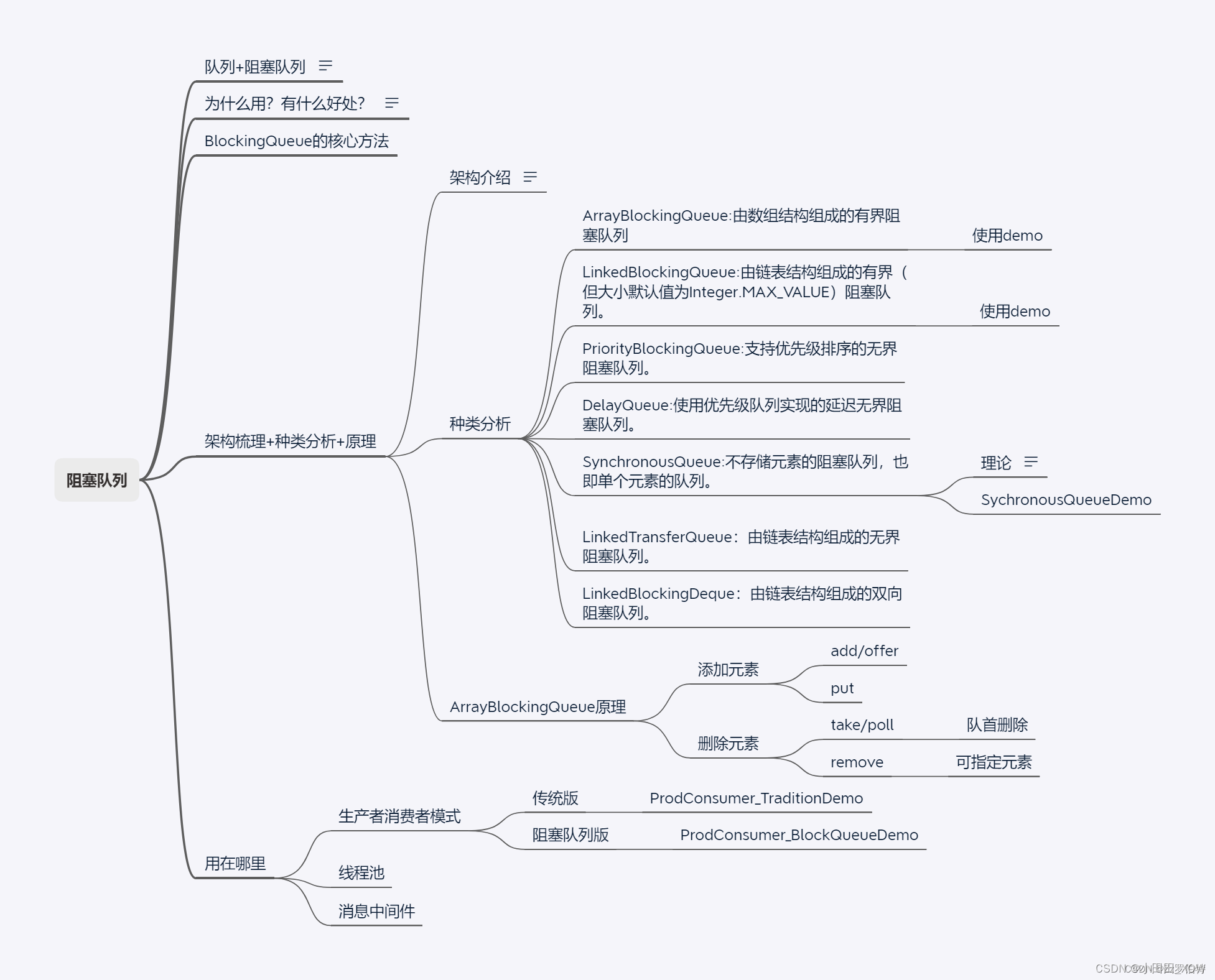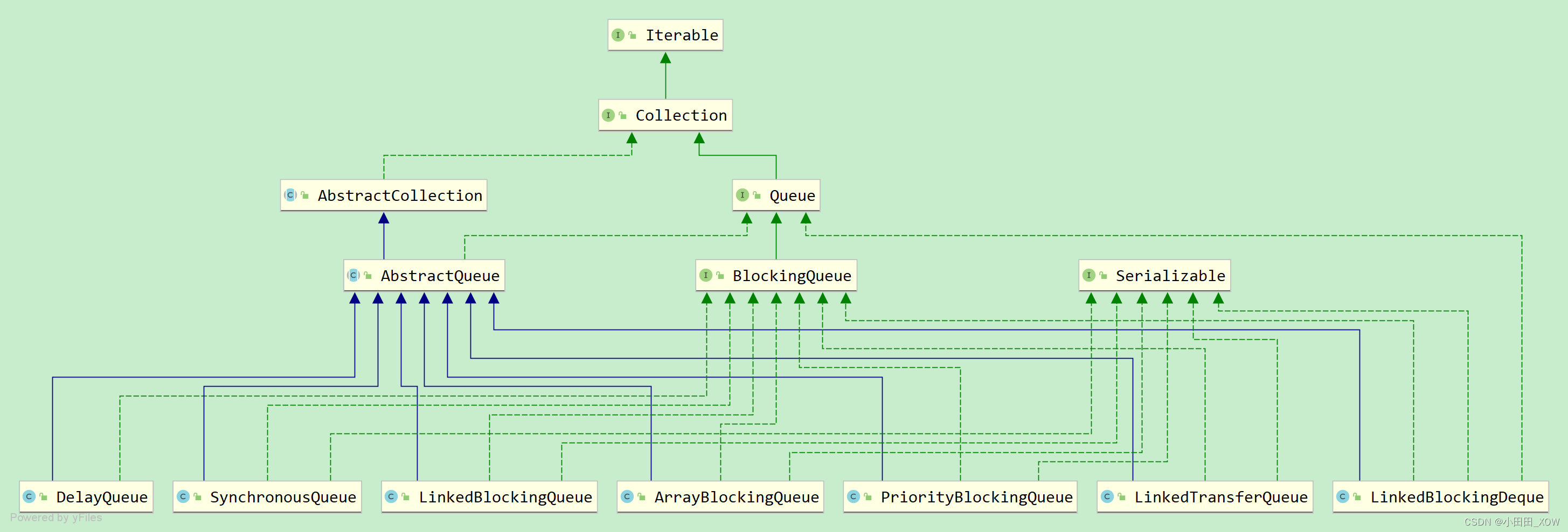
阻塞队列大纲:

什么是阻塞队列
阻塞队列:从名字可以看出,他也是队列的一种,那么他肯定是一个先进先出(FIFO)的数据结构。与普通队列不同的是,他支持两个附加操作,即阻塞添加和阻塞删除方法。
那么阻塞添加跟阻塞删除是什么意思呢?
阻塞队列的特点
如上图,线程1往阻塞队列中添加元素,而线程2从阻塞队列中移除元素。而在这一系列操作必须符合以下规定:
- 阻塞添加:当阻塞队列是满时,往队列里添加元素的操作将被阻塞。
- 阻塞移除:当阻塞队列是空时,从队列中获取元素/删除元素的操作将被阻塞。
上面的解释可能还有点晦涩难懂,那我举个例子吧:
现有三个角色:顾客,休息区,银行办理窗口。(Thread1为顾客,BlockingQueue为休息区,Thread2为银行办理窗口)。
-
正常情况下,一个银行办理窗口同一时间只能对接一个顾客;
-
恰巧今天办理的顾客有3个人,另外2个顾客怎么办,你总不至于给人家说不办了,快回家吧;
-
而正确的做法是你可以让这两个人在休息区等候,等银行窗口空闲了,然后去办理。
一个人正在银行办理业务,你后面的人不能打断(保证了原子性),或者争抢(有序性,先进先出),只能在休息区等待,直到上一个人释放资源,才轮到下一个人。
其实上面的情况面临的问题是:当一个线程占有资源的时候,你后面线程请求不得不阻塞,但这也不一定是缺点,反而更像是一件好事,因为他并不暴力的解决问题。
我们再来看一下关于阻塞的定义:
在多线程中,阻塞的意思是,在某些情况下会挂起线程,一旦条件成熟,被阻塞的线程就会被自动唤醒。
也就是说,线程的wait和notify机制是需要我们自己去手动控制,但是我们自己认为的控制是很容易出现问题的,比如死锁,逻辑判断等…
但是有了阻塞队列,一切的问题就迎刃而解了。
阻塞队列的好处
阻塞队列不用手动控制什么时候该被阻塞,什么时候该被唤醒,简化了操作。
BlockingQueue的主要方法
BlockingQueue提供的部分方法:
根据插入和取出两种类型的操作,具体分为下面一些类型:
| 方法类型 | 抛出异常 | 返回布尔 | 阻塞 | 超时 |
|---|---|---|---|---|
| 插入 | add(E e) | offer(E e) | put(E e) | offer(E e,Time,TimeUnit) |
| 取出 | remove() | poll() | take() | poll(Time,TimeUnit) |
| 队首 | element() | peek() | 无 | 无 |
-
抛出异常是指当队列满时,再次插入会抛出异常(如果队列未满,插入返回值未true);
-
返回布尔是指当队列满时,再次插入会返回false;
-
阻塞是指当队列满时,再次插入会被阻塞,直到队列取出一个元素,才能插入。
-
超时是指当一个时限过后,才会插入或者取出。
生产
add、offer、put这3个方法都是往队列尾部添加元素,区别如下:
add:不会阻塞,添加成功时返回true,不响应中断,当队列已满导致添加失败时抛出IllegalStateException。
offer:不会阻塞,添加成功时返回true,因队列已满导致添加失败时返回false,不响应中断。
put:会阻塞会响应中断。
消费
take、poll方法能获取队列头部第1个元素,区别如下:
take:会响应中断,会一直阻塞直到取得元素或当前线程中断。
poll:会响应中断,会阻塞,阻塞时间参照方法里参数timeout.timeUnit,当阻塞时间到了还没取得元素会返回null
add方法代码
public class BlockingQueueTest {
public static void main(String[] args) {
BlockingQueue<String> blockingQueue = new ArrayBlockingQueue<String>(3);
System.out.println("--------以下为add的相关操作---------");
addRemoveTest(blockingQueue);
}
public static void addRemoveTest(BlockingQueue<String> blockingQueue) {
System.out.println("添加状态+\t"+blockingQueue.add("1"));
System.out.println("添加状态+\t"+blockingQueue.add("2"));
System.out.println("添加状态+\t"+blockingQueue.add("3"));
// System.out.println("添加状态+\t"+blockingQueue.add("4"));
System.out.println("队首元素+\t"+blockingQueue.element());
System.out.println("删除元素+\t"+blockingQueue.remove());
System.out.println("队首元素+\t"+blockingQueue.element());
System.out.println("删除元素+\t"+blockingQueue.remove());
System.out.println("队首元素+\t"+blockingQueue.element());
System.out.println("删除元素+\t"+blockingQueue.remove());
// System.out.println("队首元素+\t"+blockingQueue.element());
// System.out.println("删除元素+\t"+blockingQueue.remove(blockingQueue.element()));
}
}
未打开注释代码输出如下:
--------以下为add的相关操作---------
添加状态+ true
添加状态+ true
添加状态+ true
队首元素+ 1
删除元素+ 1
队首元素+ 2
删除元素+ 2
队首元素+ 3
删除元素+ 3
当队列已满,继续添加元素时(打开注释代码),输出如下:
--------以下为add的相关操作---------
添加状态+ true
添加状态+ true
添加状态+ true
Exception in thread "main" java.lang.IllegalStateException: Queue full
at java.util.AbstractQueue.add(AbstractQueue.java:98)
...略
BlockingQueue的实现类
从整体架构图上来看,BlockingQueue是实现了Queue接口,而Queue是属于Collection接口下的派生类。

ArrayBlockingQueue 由数组构成的有界阻塞队列
LinkedBlockingQueue 由链表构成的有界阻塞队列
PriorityBlockingQueue 支持优先级排序的无界阻塞队列
DelayQueue 支持优先级的延迟无界阻塞队列
SynchronousQueue 单个元素的阻塞队列
LinkedTransferQueue 由链表构成的无界阻塞队列
LinkedBlockingDeque 由链表构成的双向阻塞队列
粗体标记的三个用得比较多,许多消息中间件底层就是用它们实现的,也是我们下面着重说明的。
SynchronousQueue: 队列只有一个元素,如果想插入多个,必须等队列元素取出后,才能插入,只能有一个“坑位”,用一个插一个。
需要注意的是LinkedBlockingQueue虽然是有界的,但有个巨坑,其默认大小是Integer.MAX_VALUE,高达21亿,一般情况下内存早爆了(在线程池的ThreadPoolExecutor有体现)。
SynchronusQueue
在这里需要特别演示以下synchronusQueue的使用,他是不存储元素的,来一个,消费一个。(同一时间内只能添加一个元素)
代码演示如下:
public class SynchronusQueueTest {
public static void main(String[] args) {
BlockingQueue<String> synchronusQueue = new SynchronousQueue<>();
new Thread(() ->{
try{
System.out.println(Thread.currentThread().getName()+"\t put 1");
synchronusQueue.put("1");
System.out.println(Thread.currentThread().getName()+"\t put 2");
synchronusQueue.put("2");
System.out.println(Thread.currentThread().getName()+"\t put 3");
synchronusQueue.put("3");
}catch(Exception e){
e.getStackTrace();
}
},"Prod").start();
new Thread(() ->{
try {
try{ TimeUnit.SECONDS.sleep(3); }catch (InterruptedException e){ e.printStackTrace(); }
System.out.println(Thread.currentThread().getName()+"\t take "+synchronusQueue.take());
try{ TimeUnit.SECONDS.sleep(3); }catch (InterruptedException e){ e.printStackTrace(); }
System.out.println(Thread.currentThread().getName()+"\t take "+synchronusQueue.take());
try{ TimeUnit.SECONDS.sleep(3); }catch (InterruptedException e){ e.printStackTrace(); }
System.out.println(Thread.currentThread().getName()+"\t take"+synchronusQueue.take());
} catch (Exception e) {
e.printStackTrace();
}
},"Cons").start();
}
输出如下:(有时间间隔)
Prod put 1
Cons take 1
Prod put 2
Cons take 2
Prod put 3
Cons take3
ArrayListBlockingQueue原理
通过源码来看,其实ArrayListBlockingQueue是通过ReentrantLock和Condition条件队列来实现阻塞的。一些成员变量如下:
//存储数据
final Object[] items;
//返回获取数据的索引,主要用于take、poll、peek、remove方法
int takeIndex;
//返回添加数据的索引,主要用于 put、offer、add 方法
int putIndex;
// 队列元素的个数
int count;
//可重入锁
final ReentrantLock lock;
//条件对象,用于通知take方法队列的线程
private final Condition notEmpty;
//条件对象,用于通知put方法队列的线程
private final Condition notFull;
//迭代器
transient Itrs itrs = null;
添加元素原理
我们再来看看元素的插入是怎么使用这个Condition条件的。添加方法有add,offer,put。我们先来看看**add(offer)**方法:
//add方法
public boolean add(E e) {
if (offer(e))
return true;
else
throw new IllegalStateException("Queue full");
}
//offer方法
public boolean offer(E e) {
//判断是否为null
checkNotNull(e);
final ReentrantLock lock = this.lock;
lock.lock();
try {
//判断队列是否满
if (count == items.length)
return false;
else {
//添加元素到队列
enqueue(e);
return true;
}
} finally {
lock.unlock();
}
}
//元素入队操作
private void enqueue(E x) {
//获取当前数组
final Object[] items = this.items;
//通过putIndex索引对数组进行赋值
items[putIndex] = x;
//索引自增,如果已是最后一个位置,重新设置 putIndex = 0;
if (++putIndex == items.length)
putIndex = 0;
//队列中元素数量加1
count++;
//唤醒调用take()方法的线程,执行元素获取操作。
notEmpty.signal();
}
首先add方法其实本质调用的是offer方法,而在offer的最关键处,也就是enqueue入队操作。
-
reentrantLock保证的线程的互斥性,即同一时间只能有一个线程操作。如果队列已满,返回ture,add方法则是抛出异常;如果队列未满,则开始入队操作。
-
在入队操作时,他会通过一个全局变量putIndex作为索引,指引着新来元素的位置。在这里有个小细节,就是判断putIndex是否与队列长度相等,如果队列已满,而且队列的操作时先进先出,索引下一次来插入元素的位置肯定时队头,也就是索引0的位置;
-
队内已经有元素了,然后开始唤醒take操作来消费元素。这个signal()其实时notify()的升级版
在添加操作中,还有一个put方法,他是会导致线程阻塞的。具体源码如下:
//put方法,阻塞时可中断
public void put(E e) throws InterruptedException {
checkNotNull(e);
final ReentrantLock lock = this.lock;
lock.lockInterruptibly();//该方法可中断
try {
//当队列元素个数与数组长度相等时,无法添加元素
while (count == items.length)
//将当前调用线程挂起,添加到notFull条件队列中等待唤醒
notFull.await();
enqueue(e);//如果队列没有满直接添加。。
} finally {
lock.unlock();
}
}
他是通过condition的await方法来实现阻塞的,但由于又添加了lockInterruptibly标识,说明其阻塞可被打断。
获取元素/删除元素原理
添加方法有remove,poll,take。我们先来看看poll方法:
public E poll() {
//reentrantLock互斥锁
final ReentrantLock lock = this.lock;
lock.lock();
try {
//如果队列为0,返回null,反之进入移除队列
return (count == 0) ? null : dequeue();
} finally {
lock.unlock();
}
}
//移除队列
private E dequeue() {
//获取当前队列数据
final Object[] items = this.items;
@SuppressWarnings("unchecked")
//获取当前队头数据
E x = (E) items[takeIndex];
//将队头数据置为null
items[takeIndex] = null;
//如果队头索引自增与数组长度相等,则将其索引设置为第一位
if (++takeIndex == items.length)
takeIndex = 0;
count--;
if (itrs != null)
//更新迭代器中的元素数据
itrs.elementDequeued();
//唤醒put/offer/add等方法
notFull.signal();
return x;
}
poll方法他是通过删除队列头数据来进行移除元素的,唤醒与沉睡机制采用reentrantLock的 condition机制。接下来我们来看一下take方法:
public E take() throws InterruptedException {
final ReentrantLock lock = this.lock;
lock.lockInterruptibly();//中断
try {
//队列没有元素,阻塞移除方法的线程
while (count == 0)
notEmpty.await();
//有元素进行元素移除操作
return dequeue();
} finally {
lock.unlock();
}
}
take方法跟poll方法一样,也是通过dequeue()方进行移除元素,但不同的是,他会进行一个线程阻塞,也就是运用condition的await方法,同时这个阻塞时可被打断的,关键词lockInterruptibly。
remove方法相对来说比较复杂,他跟以上两个方法的不同点在于remove可以根据索引来删除元素,而另两个则是通过删除队列的头元素。
public boolean remove(Object o) {
//确保传入元素不为null
if (o == null) return false;
//获取队列当前数据
final Object[] items = this.items;
final ReentrantLock lock = this.lock;
lock.lock();
try {
if (count > 0) {
final int putIndex = this.putIndex;
int i = takeIndex;
//找出O元素的索引值
do {
if (o.equals(items[i])) {//如果匹配到,删除元素,i为o的索引
removeAt(i);
return true;
}
//只有一个元素时,重置索引值
if (++i == items.length)
i = 0;
} while (i != putIndex);
}
return false;
} finally {
lock.unlock();
}
}
以下是removeAt方法:
void removeAt(final int removeIndex) {
final Object[] items = this.items;
//判断当前元素是否是头部索引值
if (removeIndex == takeIndex) {
items[takeIndex] = null;
if (++takeIndex == items.length)
takeIndex = 0;
count--;
if (itrs != null)
itrs.elementDequeued();
} else {
//如果不是,通过移动元素位置,将要删除的元素置为队尾删除
final int putIndex = this.putIndex;
for (int i = removeIndex;;) {
//确保当前队列大小大于1
int next = i + 1;
if (next == items.length)
next = 0;
//如果不是队尾元素,进行元素移动
if (next != putIndex) {
items[i] = items[next];
i = next;
} else {
//如果是队尾,元素移动完毕,直接将队尾为null,即删除
items[i] = null;
this.putIndex = i;
break;
}
}
count--;
if (itrs != null)
itrs.removedAt(removeIndex);
}
notFull.signal();
}
阻塞队列的应用场景
目前我所接触到的场景有两个:
- 线程池的底层存储;
- 生产消费队列模式。
下面我们将着重讲解生产消费队列模式,线程池我们会在专门的章节说到。
首先,我们先来演示以下如果没有阻塞队列,生产消费模式是怎样写的。然后我们在去用阻塞队列去实现。
传统模式
要求:初始值为0的变量,两个线程交替操作,一个+1,一个-1,执行五轮。
//资源类
class MyResource{
int number = 0;
private Lock lock = new ReentrantLock();
private Condition condition = lock.newCondition();
//自增
public void increaseNum(){
lock.lock();
try{
//判断
while(number != 0){
condition.await();
}
//干活
number++;
System.out.println(Thread.currentThread().getName() + "\t" + number);
//唤醒
condition.signalAll();
}catch(Exception e){
e.getStackTrace();
}finally {
lock.unlock();
}
}
//自减
public void decrNum(){
lock.lock();
try{
//判断
while(number == 0){
condition.await();
}
//干活
number--;
System.out.println(Thread.currentThread().getName() + "\t" + number);
//唤醒
condition.signalAll();
}catch(Exception e){
e.getStackTrace();
}finally {
lock.unlock();
}
}
}
public class ProdConsTradTest {
public static void main(String[] args) {
MyResource myResource = new MyResource();
new Thread(() ->{
for (int i = 0; i < 5; i++) {
myResource.increaseNum();
}
},"Prod").start();
new Thread(() ->{
for (int i = 0; i < 5; i++) {
myResource.decrNum();
}
},"Cons").start();
}
}
输出如下:
Prod 1
Cons 0
Prod 1
Cons 0
Prod 1
Cons 0
Prod 1
Cons 0
Prod 1
Cons 0
其实,通过上述代码以及上述阻塞队列的源码可以知道,传统模式的实现就是ArrayListBlockingQueue的底层代码,通过condition去通知沉睡与唤醒。
阻塞队列模式
class MyData {
//全局开关
private volatile boolean flag = true;
private BlockingQueue<String> queue;
private AtomicInteger atomicInteger = new AtomicInteger();
public MyData(BlockingQueue<String> queue) {
this.queue = queue;
}
public void myProd() throws InterruptedException {
String data = null;
boolean isOfferSuccess;
while(flag){
data = atomicInteger.incrementAndGet()+"";
isOfferSuccess = queue.offer(data, 2l, TimeUnit.SECONDS);
if(isOfferSuccess){
System.out.println(Thread.currentThread().getName()+"线程\t 插入队列成功 \t 插入队列的值为:"+data);
}else{
System.out.println(Thread.currentThread().getName()+"线程\t 插入队列失败");
}
TimeUnit.SECONDS.sleep(1);
}
}
public void myCons() throws InterruptedException {
String result =null;
while(flag){
result = queue.poll(2l, TimeUnit.SECONDS);
if(Objects.isNull(result) || result.equalsIgnoreCase("")){
flag = false;
System.err.println(Thread.currentThread().getName() + "\t超过2秒钟没有消费,退出消费");
return;
}
System.out.println(Thread.currentThread().getName() + "\t消费队列\t消费\t" + result + "\t成功");
}
}
public void stop() {
this.flag = false;
}
}
public class ProdConsBlockingQueueTest {
public static void main(String[] args) {
MyData myData = new MyData(new ArrayBlockingQueue<>(10));
new Thread(() ->{
System.out.println(Thread.currentThread().getName()+" \t 生产者线程开始生产");
try {
myData.myProd();
} catch (InterruptedException e) {
e.printStackTrace();
}
},"Pord").start();
new Thread(() ->{
System.out.println(Thread.currentThread().getName()+" \t 消费者线程开始消费");
try {
myData.myCons();
} catch (InterruptedException e) {
e.printStackTrace();
}
},"Cons").start();
try {
TimeUnit.SECONDS.sleep(5);
} catch (InterruptedException e) {
e.printStackTrace();
}
System.err.println("5秒钟后,叫停");
myData.stop();
}
}
输出如下:
Pord 生产者线程开始生产
Cons 消费者线程开始消费
Pord线程 插入队列成功 插入队列的值为:1
Cons 消费队列 消费 1 成功
Pord线程 插入队列成功 插入队列的值为:2
Cons 消费队列 消费 2 成功
Pord线程 插入队列成功 插入队列的值为:3
Cons 消费队列 消费 3 成功
Pord线程 插入队列成功 插入队列的值为:4
Cons 消费队列 消费 4 成功
Pord线程 插入队列成功 插入队列的值为:5
Cons 消费队列 消费 5 成功
5秒钟后,叫停
Cons 超过2秒钟没有消费,退出消费
LinkedBlockingQueue和ArrayBlockingQueue区别
队列大小不同;
ArrayBlockingQueue在初始化的时候,必须指定队列的大小;
而LinkedBlockingQueue在初始化的时候,如果你没有指定大小,则会默认Integer.MAX_VALUE,是一个很大的值,这样就会导致数据在一个不可控范围,一旦添加速度远大于移除的速度时,可能会有内存泄漏的风险。
底层实现不同;
ArrayBlockingQueue的底层是一个数组,而LinkedBlockingQueue底层是一个链表结构。官方文档介绍中,LinkedBlockingQueue的吞吐行是高于arrayBlockingQueue;但是在添加或移除元素中,LinkedBlockingQueue则会生成一个额外的Node对象,对GC可能存在影响;
至于为什么说LinkedBlockingQueue的吞吐性是高于arrayBlockingQueue:
吞吐性能强是因为有两个锁,试想一下,Array里面使用的是一个锁,不管put还是take行为,都可能被这个锁卡住,而Linked里面put和take是两个锁,put只会被put行为卡住,而不会被take卡住,因此吞吐性能自然强于Array。 而“less predictable performance”这个也是显而易见的,Array采用的时固定内存,而Linked采用的时动态内存,无论是分配内存还是释放内存(甚至GC)动态内存的性能自然都会比固定内存要差。
锁机制不一样;
ArrayBlockingQueue使用的一个锁来控制,LinkedBlockingQueue使用了2个锁来控制,一个名为putLock,另一个是takeLock,但是锁的本质都是ReentrantLock。
总结
其实在阻塞队列这一块,他对并发理论的运用还是很多的,都是将其封装为底层,然后直接使用,直接让我们不用要去考虑来回通知唤醒,而且也极大的可能性避免了线程死锁问题。
知识来源:























 1342
1342











 被折叠的 条评论
为什么被折叠?
被折叠的 条评论
为什么被折叠?










